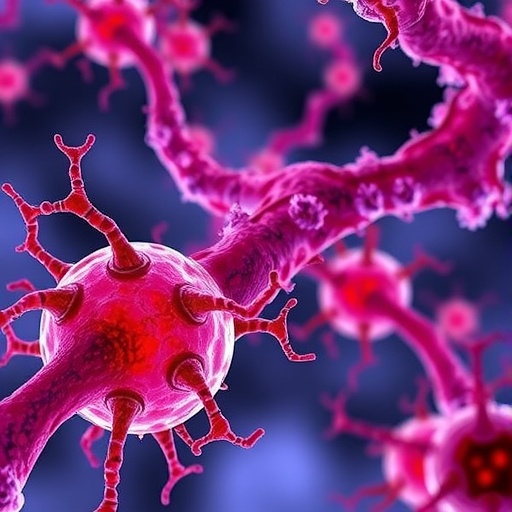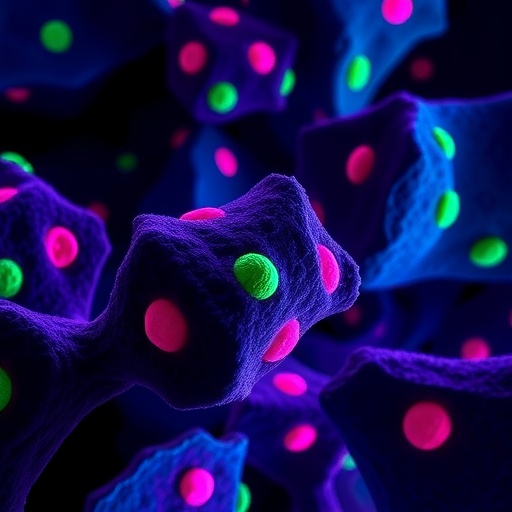Tumor invasion represents a pivotal and intricate phase in the progression of cancer metastasis, marking the transition from localized malignancy to widespread dissemination across the body. This process enables cancer cells to navigate and penetrate adjacent tissues, traverse the extracellular matrix, and eventually colonize distant organs. While the traditional paradigm of cancer research has primarily concentrated on genetic mutations and biochemical signaling networks, mounting evidence reveals that the biomechanical forces embedded within the tumor microenvironment are equally critical in orchestrating tumor invasion and metastasis.
At the mechanical level, tumors are characterized by a complex interplay of four principal biophysical properties: solid stress, interstitial fluid pressure, matrix stiffness, and organizational microstructure. Solid stress encompasses the compressive and tensile forces arising from proliferating tumor cells and the surrounding stroma, which can deform both cancerous and normal cells. Interstitial fluid pressure results from irregular vascularization and impaired lymphatic drainage, creating hydrostatic gradients that influence cell motility and drug delivery. Matrix stiffness, governed by extracellular matrix (ECM) composition and cross-linking, modulates cellular behavior through mechanotransduction. Meanwhile, tumor microstructure, defined by the spatial arrangement of cells and ECM components, governs the heterogeneity of mechanical cues perceived by cells, thus influencing invasion dynamics.
Recent advances in mechanobiology have illuminated the remarkable adaptability of tumor cells to mechanical confinement and compression within their microenvironment. Under conditions of elevated solid stress and spatial crowding, tumor cells undergo profound biochemical and structural changes to overcome physical barriers. These changes include membrane deformation, cytoskeletal remodeling, and modification of cell surface topography. Such mechanical adaptation allows cancer cells to squeeze through narrow interstitial spaces and penetrate basement membranes without necessarily relying on genetic alterations or enzymatic degradation of the ECM. This non-genetic route of invasion highlights the plasticity and resilience of tumor cells in overcoming mechanical obstacles.
Integral to this mechanoadaptive response is the concept of the biomechanical signature of tumor cells, a composite trait defined by the interplay between membrane curvature, actin cytoskeleton dynamics, and mechanical stress response pathways. Membrane curvature is not a passive physical attribute but actively sensed and regulated by specialized proteins such as BAR domain-containing and ERM family proteins. These curvature-sensing molecules transduce extracellular mechanical forces into intracellular signaling cascades, modulating cell adhesion, motility, and mechanosensitive gene expression. Such mechanotransduction pathways underpin the enhanced invasive capabilities of tumor cells subjected to mechanical stress.
Another emerging phenomenon is the notion of mechanical memory in cancer cells, whereby exposure to mechanical stimuli induces persistent phenotypic changes that endure even after the removal of such cues. This sustained mechanosensitivity is hypothesized to contribute to long-term metastatic potential, as mechanically conditioned tumor cells retain invasive traits during circulation and colonization of new tissues. Mechanical memory mechanisms likely involve epigenetic regulation and nuclear deformation, linking extracellular mechanics to genomic landscape and transcriptional programs.
To dissect the intricacies of biomechanical regulation in cancer, researchers increasingly employ three-dimensional tumor models that better recapitulate physiological tissue mechanics compared to traditional two-dimensional cultures. Technologies such as microfluidic platforms and 3D bioprinted spheroids allow precise control and measurement of mechanical forces, ECM stiffness, and spatial confinement. These advanced models faithfully mimic the intratumoral heterogeneity, fluid dynamics, and mechanical gradients experienced in vivo, providing robust experimental systems to explore tumor biomechanics and therapeutic intervention strategies.
The elucidation of tumor biomechanics also offers promising therapeutic avenues, particularly the emerging field of “migrastatics” — interventions designed to target the mechanical properties and signaling pathways that facilitate tumor invasion rather than solely focusing on tumor proliferation. Migrastatic therapies aim to modulate cytoskeletal tension, membrane curvature, or ECM stiffness to restore mechanical homeostasis within the tumor microenvironment. By interfering with the ability of cancer cells to adapt to mechanical stress, such strategies hold promise to halt cancer dissemination at its earliest and most vulnerable stages.
Integrating mechanobiology into the broader context of molecular oncology demands a multidisciplinary approach that encompasses cell biology, biophysics, bioengineering, and clinical research. Future investigations are expected to delve deeper into the roles of mechanosensitive proteins, nuclear mechanotransduction, and mechano-epigenetic modifications in governing tumor behavior. These studies will be pivotal in identifying novel biomarkers for metastatic potential and unveiling unprecedented therapeutic targets to curb the lethality of metastatic cancer.
Moreover, the dynamic reciprocity between tumor cells and their mechanical milieu underscores the importance of personalized biomechanics in cancer treatment. Tumor heterogeneity extends beyond genetic diversity to mechanical variability, necessitating tailored approaches that account for the unique biomechanical landscape of each tumor. In this context, patient-derived organoids and biomechanically tunable ECM scaffolds may serve as precision platforms to predict invasion propensity and therapeutic responsiveness.
The translation of biomechanical insights into clinical applications also challenges current drug development paradigms. Traditional chemotherapy targeting proliferative pathways may be complemented by agents that normalize tumor mechanics, enhancing drug penetration and reducing invasive escape. Additionally, mechanical biomarkers measurable via non-invasive imaging or liquid biopsies could inform prognosis and treatment stratification.
In essence, the recognition of biomechanical forces as fundamental regulators of tumor invasion revolutionizes our understanding of cancer progression. This mechanobiological perspective not only reshapes foundational cancer biology but also propels innovative approaches for early intervention, diagnostic precision, and the development of next-generation anti-metastatic therapies.
As research continues to unravel the complexities of tumor mechanics, it becomes increasingly clear that conquering cancer metastasis requires harnessing both genetic and physical realms. The integration of these domains heralds a new era in oncology—one where the physical forces within the tumor microenvironment are as critical to target as the signaling pathways they modulate. This holistic vision promises to unlock transformative breakthroughs for one of medicine’s most formidable challenges.
Subject of Research: Biomechanical forces in tumor invasion and metastasis
Article Title: The biomechanical signature of tumor invasion
Web References:
DOI link
References:
Liu, C., Wang, S., Zhang, X., Han, Y., Tan, M., Fan, J., Du, J., Fan, Y., Zhao, X. The biomechanical signature of tumor invasion. Genes & Diseases, 2025.
Image Credits: Chenhe Liu, Shijiang Wang, Xin Zhang, Yifan Han, Min Tan, Jiehou Fan, Jing Du, Yubo Fan, Xinbin Zhao
Keywords: tumor cells, metastasis, tumor microenvironment, solid stress, cytoskeletal remodeling, mechanotransduction, mechanical memory, extracellular matrix stiffness, mechanobiology, migrastatic therapy
Tags: advances in mechanobiology researchbiophysical properties of tumorscancer cell motility factorscancer invasion mechanismscancer metastasis dynamicsECM composition and cancer behaviorinterstitial fluid pressure in tumorsmatrix stiffness and cancer cellsmechanotransduction in cancersolid stress in tumor progressiontumor microenvironment biomechanicstumor microstructure and invasion





